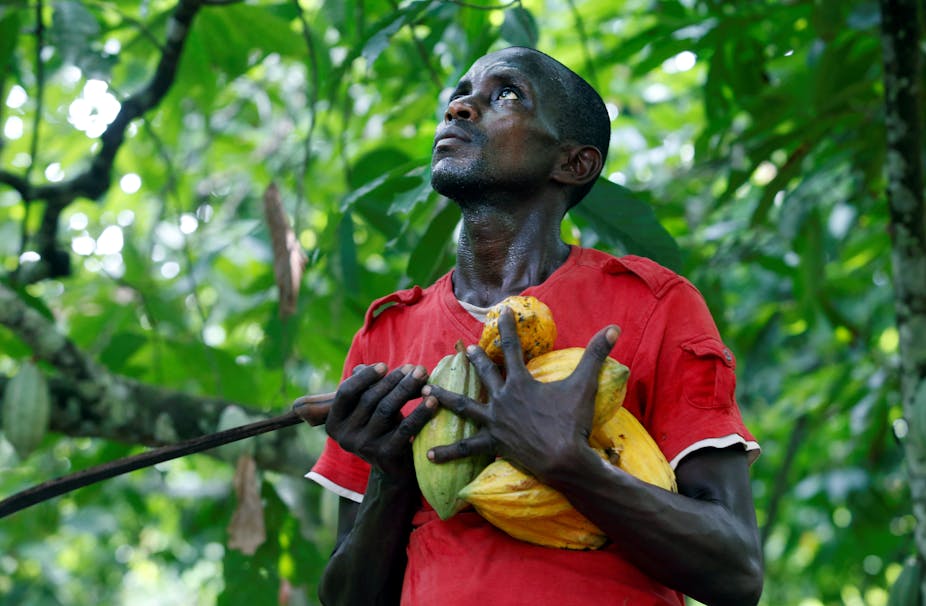At a bare floored restaurant on the edge of the Dja Faunal Reserve in Cameroon, I asked the owner what there was to eat. She gestured to a poster on the wall. It was an illustrated guide of 44 animal species under threat from poaching and over-hunting, but for the restaurant it served as a menu. Each animal she pointed to was available to order.
The Dja, and other forests in Central Africa’s Congo Basin, are a breadbasket for millions of people living in the region. At nearly 2 million square kilometres, the area of tropical forest in the Congo Basin is the second largest in the world after the Amazon. Besides supplying bushmeat, these forests provide building materials, medicine, wild fruits, vegetables and spices. They also regulate the local climate and flow of water, play an important role in soil conservation by retaining soil fertility and preventing erosion and cycling nutrients for crops grown under their shaded canopy. These forests are also home to thousands of endemic plant and animal species, including the okapi.
While these forests have long been threatened by logging, over-hunting, and small-scale subsistence farming, they remain mostly intact relative to other parts of the tropics like the Brazilian Amazon or Indonesia.
But there are rising concerns that trends in rapid deforestation across the Amazon and Southeast Asia could spread to Africa.
In particular, some worry that continued demand for commodity crops will lead to large-scale agricultural expansion in Africa where it’s estimated, that 50%-67% of the land suitable for agriculture is still forest.
To date, agricultural expansion in sub-Saharan Africa has mainly been driven by small-scale subsistence farmers. Yet since 2005, 22.7 million hectares of land in sub-Saharan Africa has been acquired by large-scale landholders.
We examined recent trends in domestic and export-oriented agricultural expansion in sub-Saharan Africa. Our aim was to establish whether patterns are changing and to identify countries at risk of expansion into tropical forests.
Our results indicate that although cropland expansion in sub-Saharan Africa is still dominated by production for domestic markets, there’s evidence of a growing influence of global markets on change in land use across the region. We believe it’s not too late to introduce policies that take this into account, and protect Africa’s rainforests from the same levels of destruction seen in Asia and Latin America.
Deforestation
Globalisation has transformed the way markets operate. Low-cost and more efficient modes of production far from consumers have supported a steady increase in international investments. As part of this trend, the availability of cheaper land and labour in the tropics is attracting investors interested in food, fibre and bio-fuel production. This pattern of land use change has resulted in tropical forests becoming frontiers of conversion for commodity crop agriculture.
By 2004, Brazil’s deforestation rate surged to over 27 thousand square kilometres of forest loss per year as a result of expanding soy fields and cattle pastures driven by global beef demands. That equates to losing a portion of the Amazon every year comparable to the size of Rwanda. As rapid policy responses led to the reduction of deforestation in Brazil, Indonesia became the country with the highest rate of deforestation in 2011. The main culprit was rapid oil palm expansion driven by global vegetable oil demands.
Africa has not yet seen these levels of agricultural expansion associated with foreign demands. But recent trends suggest it could be on the way. For example, cocoa, the fastest expanding export-oriented crop, increased at a rate of 132 thousand hectares per year across the whole continent. This amounted to 57% of the global cocoa expansion in 2000–2013.
Of particular concern is the potential threat to the Congo Basin. We found four Congo Basin countries, as well as Sierra Leone, Liberia, and Côte d’Ivoire to be most at risk in terms of deforestation from agricultural expansion. These countries average 58% forest cover with only 1% of available cropland outside forest areas. Over 80% of foreign investment in these countries was concentrated in oil palm production, with a median investment area of 41 thousand hectares.

But unlike recent trends in South America and Southeast Asia commodity crop expansion in sub-Saharan Africa does not appear to be driven by large-scale, industrial plantations – at the moment. For example, since 2000 oil palm expansion has accelerated in Cameroon, Côte d’Ivoire and the Republic of Congo. Yet our analysis on Cameroon suggests that expansion is largely driven by small- and medium-scale farmers. Over 83% of monoculture commodity crop expansion occurred outside industrial plantations.
Where this leaves the tropical forests of Africa is difficult to say. The landscape is largely intact with relatively low rates of deforestation. There is an opportunity to conserve this vital ecosystem before economic pressures push conservation out of reach.
The use of an endangered species poster as a menu illustrates the complications and trade-offs between conserving a forest for its ecosystem services and prioritising the urgent development needs of nearby communities. Additional agricultural pressures from global food demands could further complicate these trade-offs.

